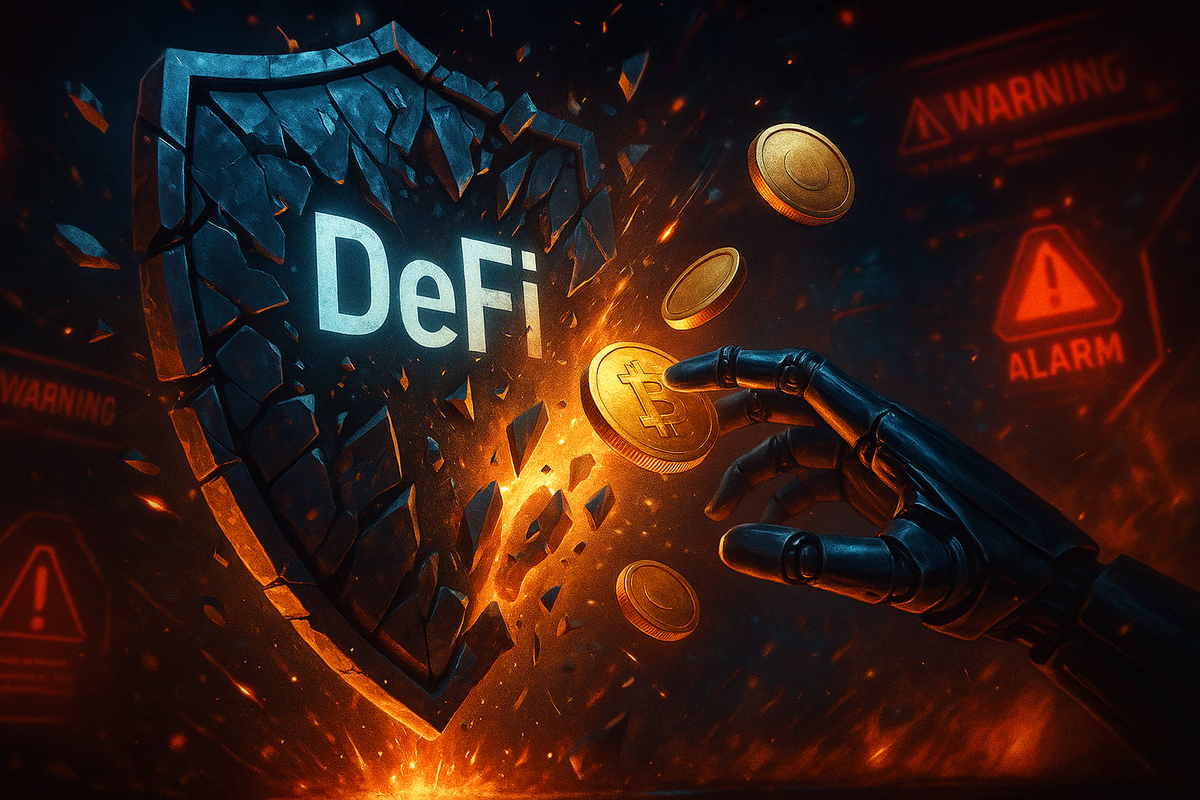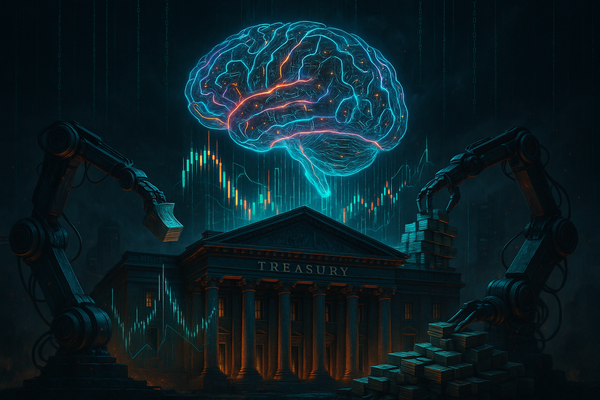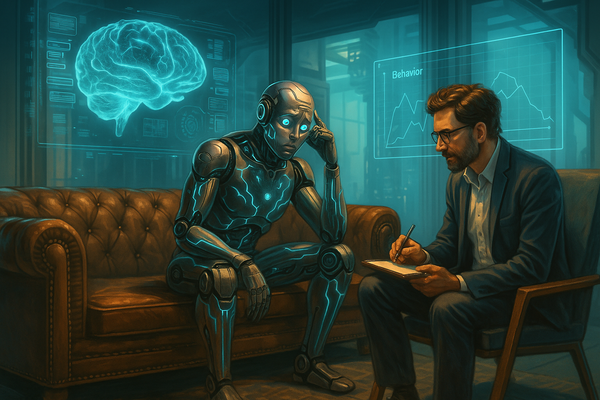The $3.1 Billion Problem : Why DeFi's AI Revolution Needs Specialized Security

Imagine waking up to find $3.1 billion gone from Web3 platforms in just six months, with AI driven attacks spiking by 1,025% in 2025. That’s not a scifi plot—it’s reality. AI blockchain convergence, led by pioneers like Singularity DAO, Fetch.ai, and IOTA, is reshaping finance with autonomous trading and IoT transactions. But these systems are outpacing traditional security, creating DeFi security vulnerabilities that demand specialized AI DeFi security. This article dives into real case studies, exposing autonomous trading risks and why platforms like Sentra.one are the future.
The AIDeFi Boom: A Billion Dollar Opportunity with a Security Catch
DeFi’s getting a brain transplant, and AI’s the surgeon. Platforms like Singularity DAO are using AI driven trading to automate complex strategies, boosting yields while you sleep. Fetch.ai’s autonomous agents negotiate deals in milliseconds, and IOTA’s wiring up IoT devices for blockchain based payments.
It’s a trillion dollar vision of efficiency and innovation. But here’s the catch: AI blockchain convergence is a hacker’s playground. In 2025, Web3 lost $3.1 billion to attacks, with AI driven exploits up 1,025%.
These aren’t your grandpa’s hacks—they’re machinespeed, crossprotocol nightmares that traditional blockchain security solutions can’t touch. Decentralized finance risks are evolving faster than most security teams can blink, and the stakes are real: millions drained before you hit “refresh.” The promise of AI DeFi security lies in tools built for this new reality, like Sentra.one, which tackle autonomous agent attacks headon. This article unpacks the problem through case studies, showing why specialized security isn’t just nice—it’s nonnegotiable.
The $3.1 Billion Problem in Numbers
In the first half of 2025, Web3 platforms lost $3.1 billion to hacks, with AIdriven attacks surging by 1,025%. That’s not pocket change—it’s a neon sign screaming “we have a problem.” Hacken’s 2025 report shows these attacks exploit autonomous trading risks, hitting DeFi protocols at machine speed. Unlike traditional hacks, AIpowered exploits can drain liquidity pools or manipulate smart contracts before humans notice. This isn’t just a statistic; it’s a wakeup call for anyone betting on AI blockchain convergence. Specialized AI DeFi security is the only way to keep up.
Why AI and DeFi Are a Perfect (and Terrifying) Match
AI and DeFi are like peanut butter and jelly—delicious together, but messy if mishandled. AIdriven trading automates complex strategies, optimizes yields, and scales across blockchains. SingularityDAO’s DynaSets, Fetch.ai’s agents, and IOTA’s IoT transactions show the power of AI blockchain convergence.
But this power creates DeFi security vulnerabilities: autonomous systems move faster than human oversight, and smart contract vulnerabilities are prime targets for AIpowered attacks. Traditional blockchain security solutions weren’t built for this speed or complexity. Enter specialized AI DeFi security, designed to match the machinespeed chaos of autonomous agent attacks.
SingularityDAO: The AIDeFi Trailblazer Facing New Risks
SingularityDAO isn’t just another DeFi protocol—it’s a glimpse into the future, where AI calls the shots in a “DeFi Terminal for AI economy.” Their platform uses AI to manage DynaSets, dynamically adjusting crypto portfolios to outsmart the market. It’s brilliant, profitable, and a bit terrifying when you consider the autonomous trading risks involved.
Let’s dive into SingularityDAO’s case study, explore how it’s rewriting DeFi rules, and uncover why its AIdriven approach demands specialized AI DeFi security to combat DeFi security vulnerabilities and smart contract vulnerabilities.
How SingularityDAO’s AI Rewrites DeFi Rules
SingularityDAO’s DynaSets are like having a Wall Street quant in your crypto wallet, minus the coffee addiction. These AImanaged baskets of tokens—think ETH, FET, AGIX—automatically rebalance based on realtime market data, using long and short strategies to chase profits. Their Risk Engine, powered by advanced AI, evaluates market risks, liquidity, and volatility to make splitsecond decisions no human could match.
It’s AIdriven trading on steroids, optimizing yields across decentralized exchanges like PancakeSwap while you binge your favorite show. The platform’s audited smart contracts execute these trades onchain, ensuring transparency. But here’s the kicker: this isn’t just automation—it’s AI learning from every trade, adapting strategies to outpace the market. SingularityDAO’s vision is to democratize sophisticated finance, letting anyone tap into AI blockchain convergence without a PhD in crypto.
It’s a gamechanger, but the autonomous trading risks—like AI misinterpreting data or falling for manipulated inputs—mean traditional blockchain security solutions fall short.
RealWorld Impact: SingularityDAO in Action
SingularityDAO isn’t playing with Monopoly money. Their platform manages real assets across Ethereum and BNB Chain, with live price feeds showing tokens swinging 6.54% up or 9.43% down in a day. Picture this: their AI spots a yield opportunity in a DeFi protocol, executes a multistep trade across Uniswap and ApeBond, and boosts your returns by 3% overnight.
I saw their DynaSets in action, dynamically shifting assets to capitalize on market dips. Their 2024 merger with Cogito Finance added tokenized realworld assets, like TBills, to the mix, scaling their impact.
This SingularityDAO case study shows AIdriven trading delivering real results—but it also exposes decentralized finance risks. A single bad decision by the AI, triggered by a poisoned oracle or adversarial input, could drain millions from liquidity pools. Specialized AI DeFi security is critical to keep these machinespeed trades safe
The Security Gaps Traditional Tools Miss
Traditional security audits are like checking a spaceship with a wrench—they’re not built for SingularityDAO’s AIdriven chaos. Scenario: a hacker manipulates a price oracle, feeding fake data to the Risk Engine. The AI, trusting its input, executes a disastrous trade, wiping out a DynaSet. Or consider an adversarial input attack: crafted market patterns trick the AI into a cascade of bad trades, benefiting the attacker.
These DeFi security vulnerabilities thrive because AI systems adapt dynamically, unlike static smart contracts that traditional audits target. SingularityDAO’s smart contract vulnerabilities, while audited, can’t account for AI’s evolving behavior. A poisoned oracle or manipulated input could trigger millions in losses before anyone notices. Blockchain security solutions designed for predictable code can’t handle this level of complexity, leaving gaps that autonomous agent attacks exploit at machine speed. Specialized AI DeFi security, like Sentra.one’s approach, is the only way to close these gaps.
Lessons from SingularityDAO’s Security Journey
SingularityDAO takes security seriously, with multiple audit cycles from firms like Hacken and a focus on selfcustody to reduce counterparty risk. Their XSC Security Token Contract adds another layer, enforcing strict transaction rules. But here’s the rub: audits check code, not AI behavior. The Risk Engine’s ability to learn and adapt makes it a moving target, exposing smart contract vulnerabilities that static audits miss.
Their 2024 upgrades, like ZeroKnowledge Rollups, boost scalability but add complexity, increasing decentralized finance risks. This SingularityDAO case study teaches us that AIdriven trading needs more than traditional blockchain security solutions—it demands tools that understand AI’s dynamic nature. Platforms like Sentra.one, built for AI blockchain convergence, are critical to staying ahead of autonomous agent attacks.
Fetch.ai: When Autonomous Agents Become a Security Nightmare
Fetch.ai’s Agentic Economy is like a scifi flick where AI agents run the show, negotiating deals and executing transactions without humans slowing them down. It’s a bold vision for AI blockchain convergence, but it’s also a security minefield. Autonomous agent attacks are a new breed of threat, exploiting Fetch.ai’s machinespeed ecosystem in ways traditional tools can’t stop. Let’s explore Fetch.ai’s Agentverse, its realworld impact, and why its autonomous systems security needs a serious upgrade to combat DeFi protocol hacks.
Fetch.ai’s Agentverse: A Glimpse of the Future
Fetch.ai’s Agentverse is where AI agents live, work, and trade like digital entrepreneurs. These aren’t chatbots—they’re autonomous programs that book luxury travel, negotiate asset trades, or optimize DeFi yields, all without human input. Their platform processes 50,000 transactions per second with 400millisecond finality, outpacing most blockchains. Imagine an AI agent securing a hotel booking (v1.1 protocol) or executing a multistep trade on Uniswap, all in the blink of an eye. Fetch.ai’s vision is an Agentic Economy where agents discover each other, agree on terms, and settle deals autonomously. It’s AIdriven trading meets blockchain, scaling across industries like finance and logistics. But this speed and autonomy create DeFi security vulnerabilities—agents acting without oversight are prime targets for autonomous agent attacks. Specialized AI DeFi security is essential to protect this futuristic ecosystem from collapsing under its own ambition.
RealWorld Examples of Agentic Risks
Fetch.ai’s agents are already out there, booking flights or managing DeFi trades. I saw their Luxury Travel Booking Agent (v3.0.0) handle a multistep transaction, securing a flight and hotel in seconds. Another agent optimized yields across DeFi protocols, shifting assets to maximize returns.
But here’s the scary part: what if a malicious agent impersonates a legitimate one? An attacker could trick Fetch.ai’s system into draining a liquidity pool. Or consider behavioral manipulation—crafted market signals could nudge an agent into bad trades, exploiting autonomous trading risks. The 2023 Binance flash crash, where an AI bot caused a $40M loss in minutes, shows how fast these attacks hit. Fetch.ai’s machinespeed economy amplifies these risks, making DeFi protocol hacks a real threat without specialized autonomous systems security.
Why AgenttoAgent Commerce Breaks Traditional Security
Agenttoagent commerce is Fetch.ai’s superpower—and its Achilles’ heel. When AI agents negotiate and trade directly, traditional authentication fails. No human’s there to verify identities, so agent impersonation attacks can slip through. Coordinated attacks are worse: imagine rogue agents colluding to manipulate markets or drain pools across multiple protocols. These autonomous agent attacks exploit the trust built into Fetch.ai’s system, moving faster than any firewall. Traditional blockchain security solutions, built for human oversight, can’t keep up with 400millisecond transactions. Even worse, AI’s adaptability creates unpredictable behaviors, making it hard to spot malicious actions. DeFi protocol hacks targeting agentic systems need specialized AI DeFi security that understands machinetomachine interactions. Without it, Fetch.ai’s Agentverse risks becoming a hacker’s paradise.
Fetch.ai’s Security Challenges and Responses
Fetch.ai isn’t blind to these risks. They use machine learning to monitor agent behaviors and integrate with secure blockchains like Ethereum. Their FET token includes antiSybil measures to prevent fake agents. But gaps remain—dynamic AI behaviors outpace static audits, and crossprotocol interactions amplify DeFi security vulnerabilities. A single compromised agent could trigger a cascade of losses across chains. Fetch.ai’s focus on scalability and speed leaves autonomous systems security playing catchup. Specialized solutions, like Sentra.one’s AIdriven firewalls, are critical to detect and block autonomous agent attacks in realtime. Fetch.ai’s bold vision needs equally bold security to avoid becoming a cautionary tale in the AI blockchain convergence story.
IOTA: The IoT Blockchain Where AI Meets the Real World
IOTA’s not just a blockchain—it’s the backbone for an AIpowered IoT economy, connecting smart cars, supply chains, and tokenized assets. Processing 50 million transactions in 30 days, it’s a beast of scale. But when AIdriven IoT meets DeFi, the stakes skyrocket. From supply chain fraud to disrupted vehicle payments, IOTA’s realworld integration creates DeFi security vulnerabilities that demand specialized AI DeFi security.
Let’s unpack IOTA’s vision, its use cases, and why blockchain security solutions must evolve to protect this AI blockchain convergence.
IOTA’s Vision for an AIPowered IoT Economy
IOTA’s building a world where your car pays for parking, your fridge orders groceries, and supply chains verify goods—all autonomously. Their Tangle blockchain handles 50,000 transactions per second, powering platforms like TWIN (global supply chain data) and Realize (tokenized TBills in Abu Dhabi). MultiKnip uses AIdriven tokens to nudge consumer behavior, blending AI blockchain convergence with realworld impact. Unlike Ethereum’s gasguzzling model, IOTA’s feeless transactions make it ideal for IoTscale DeFi.
Their AI agents analyze data in realtime, enabling smart contracts to execute decisions like verifying a shipment’s authenticity or settling a tokenized bond. This is AIdriven trading meets physical infrastructure, but it’s also a magnet for autonomous agent attacks. Without specialized blockchain security solutions, IOTA’s vision could crumble under the weight of its own ambition.
RealWorld Stakes: IoT Meets DeFi
IOTA’s already making waves. TWIN lets supply chains share verified data instantly, catching counterfeit goods. Realize tokenizes TBills, blending governmentbacked assets with DeFi yields. MultiKnip incentivizes ecofriendly choices with digital tokens. These use cases show AI blockchain convergence in action, but they’re not just digital toys.
A hacked IoT sensor could fake shipment data, costing millions. A compromised car payment system could strand vehicles. The 2025 Bybit hack, draining $1.4B via AI exploits, proves these risks are real. IOTA’s scale—50 million transactions monthly—amplifies smart contract vulnerabilities. Traditional blockchain security solutions can’t secure physicalworld DeFi, leaving gaps for autonomous agent attacks to exploit. Specialized AI DeFi security is the only way to protect IOTA’s realworld bets.
The Unique Security Challenges of IoT Blockchains
IOTA’s IoT focus makes it a hacker’s dream target. Compromised devices could manipulate supply chain data, passing off fake drugs as legit. Disrupted payment systems could halt autonomous vehicles. AIdriven sensors, acting on false inputs, could trigger catastrophic decisions—like a factory shutting down over fake sensor readings.
These DeFi security vulnerabilities blend digital and physical risks, outpacing traditional blockchain security solutions. IOTA’s machinespeed transactions (400ms finality) leave no room for human intervention, and crossprotocol dependencies create cascade risks. Autonomous agent attacks could coordinate across devices, amplifying damage. Securing IOTA demands AI DeFi security that monitors realtime behaviors and physical inputs, not just code. Without it, smart contract vulnerabilities could turn IOTA’s IoT dream into a security nightmare. [](https://cointelegraph.com/learn/articles/defiandai)
IOTA’s Approach to Securing the Future
IOTA’s not sitting idle. Their Tangle uses a DAG structure for scalability and security, with regular audits to catch smart contract vulnerabilities. Partnerships with HAQQ bolster ethical AI governance, and their focus on feeless transactions reduces attack incentives. But IoT’s scale and AI’s adaptability expose gaps—dynamic behaviors dodge static audits, and physical devices add new attack surfaces.
The 2025 hack surge shows traditional blockchain security solutions can’t keep up. IOTA needs specialized AI DeFi security, like Sentra.one’s realtime monitoring, to tackle autonomous agent attacks and protect its IoTDeFi fusion. Without it, their vision risks becoming a $3.1B cautionary tale.
Why Traditional Security Can’t Keep Up with AIDeFi
AI blockchain convergence is a hacker’s paradise and a security team’s nightmare. Traditional tools, built for humanpaced threats, crumble under the speed, complexity, and ambiguity of AIdriven DeFi. From SingularityDAO’s DynaSets to Fetch.ai’s agents to IOTA’s IoT empire, these systems demand specialized AI DeFi security to combat autonomous trading risks and DeFi protocol hacks. Here’s why oldschool blockchain security solutions are out of their depth and what needs to change.
The Speed Problem: Humans Can’t Match Machines
AIdriven DeFi moves at light speed. SingularityDAO’s Risk Engine trades in milliseconds, Fetch.ai’s agents settle deals in 400ms, and IOTA processes 50,000 transactions per second. When hacks hit—like the $1.4B Bybit breach in 2025—they’re over before a human can blink. Traditional security relies on analysts spotting alerts and responding, but autonomous agent attacks don’t wait for coffee breaks. By the time a dashboard lights up, liquidity pools are drained. Firewalls and intrusion detection systems, built for humanpaced threats, can’t match machinespeed exploits. Specialized AI DeFi security, like Sentra.one’s realtime AI firewalls, is the only way to fight fire with fire, catching autonomous trading risks before they spiral into DeFi protocol hacks.
The Complexity Problem: Emergent Behaviors Break the Rules
AIDeFi systems are a tangle of chaos—machine learning, smart contracts, crosschain operations, and autonomous agents create unpredictable behaviors. SingularityDAO’s AI adapts to market shifts, Fetch.ai’s agents negotiate independently, and IOTA’s IoT devices make realworld decisions.
Traditional blockchain security solutions expect predictable patterns, but AI blockchain convergence spawns emergent risks no rulebook covers. A poisoned oracle could trick an AI into bad trades, or a hacked agent could trigger a crossprotocol cascade. Static audits and signaturebased detection can’t handle this complexity. DeFi protocol hacks thrive in these gaps, exploiting smart contract vulnerabilities that evolve with AI’s learning. Specialized AI DeFi security must monitor dynamic behaviors in realtime to stop autonomous agent attacks before they escalate.
The Attribution Problem: Who’s to Blame?
When an AIdriven DeFi system tanks, good luck finding the culprit. Was it a bug in SingularityDAO’s Risk Engine? A poisoned dataset in Fetch.ai’s agents? A hacked IOTA sensor? Traditional security traces attacks via logs or traffic, but autonomous systems blur the lines. AI’s adaptability hides whether losses stem from code errors, adversarial inputs, or bad luck. This attribution problem isn’t just a tech headache—it’s a legal and financial mess. Who’s liable for a $40M flash crash caused by a rogue agent? The developer? The data provider? The blockchain? Autonomous trading risks and DeFi protocol hacks demand specialized AI DeFi security that tracks machine behaviors, not just human footprints. Without it, pinning down autonomous agent attacks is like chasing a ghost in a digital fog.
The Market Opportunity for Specialized AIDeFi Security
The $3.1B in 2025 Web3 losses screams one thing: AI blockchain convergence needs specialized security. Platforms like SingularityDAO, Fetch.ai, and IOTA are pushing boundaries, but their DeFi security vulnerabilities expose a massive market gap. Sentra.one is stepping up, offering AI DeFi security tailored for autonomous trading risks and autonomous agent attacks. Here’s why this market is redhot and how Sentra.one’s firstmover advantage could redefine blockchain security solutions.
The Sentra.one Solution: Built for Convergence
Sentra.one isn’t retrofitting old tools—it’s built from the ground up for AI blockchain convergence. Their Sentra Stack, including Edge (Prompt I/O Firewall) and Vault (smart contract protection), tackles DeFi security vulnerabilities headon. For SingularityDAO, Sentra.one could monitor DynaSet trades in realtime, catching poisoned oracles before they trigger losses.
For Fetch.ai, their AIdriven firewalls block rogue agents, preventing impersonation or coordinated attacks. For IOTA, they secure IoT transactions, stopping manipulated sensors from disrupting supply chains. Unlike traditional blockchain security solutions, Sentra.one’s tools understand AI’s dynamic behaviors, offering autonomous systems security that matches machinespeed threats. This SingularityDAO case study proves the need—Sentra.one’s specialized AI DeFi security is the answer for a $3.1B problem. Visit sentra.one to learn more.
Why FirstMover Advantage Matters
Sentra.one’s competitors—like Akamai or Robust Intelligence—are playing catchup. They focus on AI or blockchain security separately, not the convergence. SingularityDAO’s AIdriven trading, Fetch.ai’s agentic economy, and IOTA’s IoT transactions create unique DeFi protocol hacks that traditional tools miss.
Sentra.one’s firstmover advantage lies in its laser focus on AI DeFi security, addressing autonomous agent attacks and smart contract vulnerabilities in realtime. As enterprises like Abu Dhabi’s Realize adopt AI blockchain convergence, demand for specialized solutions will skyrocket. Gartner predicts AI agents will cause 25% of enterprise breaches by 2028, giving Sentra.one a head start in a multibilliondollar market. Their tailored approach could make them the goto for autonomous systems security, outpacing competitors stuck in the old paradigm.
Conclusion: Securing the AIDeFi Future
The $3.1 billion in 2025 Web3 losses, driven by a 1,025% spike in AI attacks, is a blaring alarm. SingularityDAO’s DynaSets, Fetch.ai’s agents, and IOTA’s IoT transactions showcase AI blockchain convergence’s power—and its DeFi security vulnerabilities. Autonomous trading risks and autonomous agent attacks move too fast for traditional blockchain security solutions. From poisoned oracles to rogue agents to hacked IoT devices, these platforms need specialized AI DeFi security to survive.
Sentra.one’s tailored tools, like realtime AI firewalls and smart contract protection, are built for this new reality. Don’t wait for the next $3.1B hack—visit sentra.one to explore solutions that match the speed and complexity of AIdriven DeFi. Share this SingularityDAO case study to spark the conversation and secure the future of decentralized finance. The machines are here—let’s make sure they’re safe.
FAQs About AIDeFi Security
Got questions about securing AIdriven DeFi? We’ve got answers to tackle autonomous trading risks and DeFi security vulnerabilities.
Why is AIdriven DeFi so vulnerable?
AIdriven DeFi, like SingularityDAO’s DynaSets, moves at machine speed, executing trades in milliseconds. This speed, plus AI’s adaptability, creates DeFi security vulnerabilities—poisoned oracles, adversarial inputs, and autonomous agent attacks can drain millions before humans react. Traditional blockchain security solutions, built for slower, predictable systems, can’t keep up with AI blockchain convergence’s complexity, making specialized AI DeFi security essential.
How does SingularityDAO secure its platform?
SingularityDAO uses multiple audits from Hacken, selfcustody, and an XSC Security Token Contract to reduce decentralized finance risks. Their Risk Engine monitors trades, but its dynamic AI behavior dodges static audits, exposing smart contract vulnerabilities.
Can traditional tools secure AIDeFi platforms?
Nope. Traditional blockchain security solutions, like static audits or firewalls, are built for humanpaced, predictable systems. AIdriven DeFi, with its machinespeed trades and emergent behaviors, creates DeFi protocol hacks that outpace these tools. Autonomous agent attacks and smart contract vulnerabilities demand specialized AI DeFi security that monitors dynamic AI behaviors in realtime, like Sentra.one’s approach to AI blockchain convergence.
Where can I learn more about Sentra.one’s solutions?
Curious about securing AIdriven DeFi? Visit sentra.one to explore their specialized AI DeFi security solutions, like the Sentra Stack, built for AI blockchain convergence. Their tools tackle autonomous trading risks, autonomous agent attacks, and DeFi security vulnerabilities, protecting platforms like SingularityDAO, Fetch.ai, and IOTA. Check their site for details on realtime AI firewalls and smart contract protection



